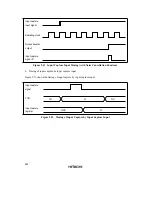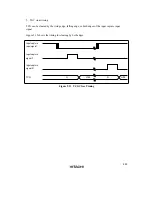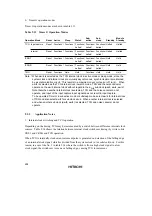
224
6. Timer G operation modes
Timer G operation modes are shown in table 9.13.
Table 9.13
Timer G Operation Modes
Operation Mode
Reset Active
Sleep
Watch
Sub-
active
Sub-
sleep
Standby
Module
Standby
TCG Input capture
Reset
Functions
*
Functions
*
Functions/
halted
*
Functions/
halted
*
Functions/
halted
*
Halted
Halted
Interval
Reset
Functions
*
Functions
*
Functions/
halted
*
Functions/
halted
*
Functions/
halted
*
Halted
Halted
ICRGF
Reset
Functions
*
Functions
*
Functions/
halted
*
Functions/
halted
*
Functions/
halted
*
Held
Held
ICRGR
Reset
Functions
*
Functions
*
Functions
halted
*
Functions/
halted
*
Functions/
halted
*
Held
Held
TMG
Reset
Functions
Held
Held
Functions Held
Held
Held
Note:
*
When øw/4 is selected as the TCG internal clock in active mode or sleep mode, since the
system clock and internal clock are mutually asynchronous, synchronization is maintained
by a synchronization circuit. This results in a maximum count cycle error of 1/ø (s). When
øw/4 is selected as the TCG internal clock in watch mode, TCG and the noise canceler
operate on the øw/4 internal clock without regard to the ø
SUB
subclock (øw/8, øw/4, øw/2).
Note that when another internal clock is selected, TCG and the noise canceler do not
operate, and input of the input capture input signal does not result in input capture.
To be operated Timer G in subactive mode or subsleep mode, select øw/4 for internal clock
of TCG and also select øw/2 for sub clock ø
SUB
. When another internal clock is selected
and when another sub clock (øw/8, øw/4) is selected, TCG and noise canceler do not
operate.
9.5.5
Application Notes
1. Internal clock switching and TCG operation
Depending on the timing, TCG may be incremented by a switch between difference internal clock
sources. Table 9.14 shows the relation between internal clock switchover timing (by write to bits
CKS1 and CKS0) and TCG operation.
When TCG is internally clocked, an increment pulse is generated on detection of the falling edge
of an internal clock signal, which is divided from the system clock (ø) or subclock (øw). For this
reason, in a case like No. 3 in table 9.14 where the switch is from a high clock signal to a low
clock signal, the switchover is seen as a falling edge, causing TCG to increment.
















































